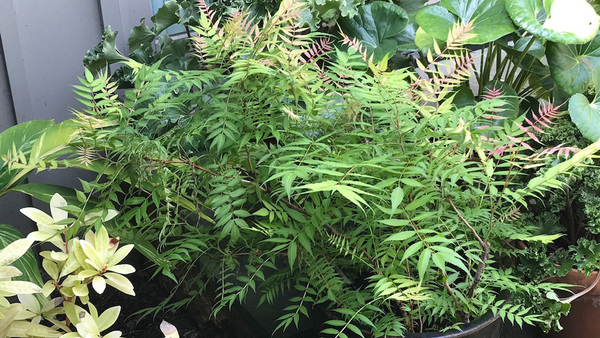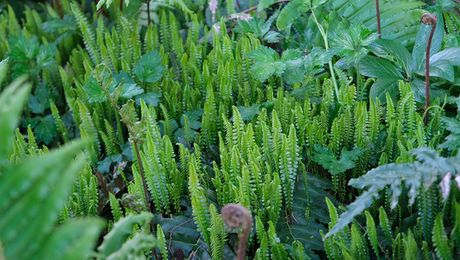
My first encounter with Cotoneaster ‘Tom Thumb’ (syn. C. ‘Little Gem’, USDA Hardiness Zones 5–7) was accidental. I was in a local nursery hunting down plants for a job. I couldn’t find the varieties I wanted, when ‘Tom Thumb’ caught my attention. I was intrigued by its shiny dense foliage and diminutive size. I took it with me and used it in a rock garden. It provided the perfect backdrop for a mass of gray-blue juniper (Juniperus squamata ‘Blue Star’, Zones 4–9) and chartreuse dwarf chamaecyparis (Chamaecyparis pisifera ‘Filifera Aurea Nana’, Zones 4–8). Since then, I’ve become this plant’s biggest fan.
This tidy, virtuous cotoneaster grows low to the ground and is self-rooting, making it a useful underplanting or ground cover. Unlike most cotoneasters, it doesn’t gobble up space. Instead, the aptly named ‘Tom Thumb’ remains compact at 8 to 12 inches tall with an eventual spread of 3 to 6 feet. It requires little or no pruning. It doesn’t flower or fruit, but its leaves turn a brilliant red in the fall.
Since ‘Tom Thumb’ is a relatively slow grower, it also combines well with perennials. Small-flowered plants with delicate foliage, such as Coreopsis verticillata ‘Moonbeam’ (Zones 3–8) or dwarf Gypsophila repens ‘Rosea’ (Zones 4–7), stand out nicely against its dark, shiny leaves. Gray-leaved plants like catmints (Nepeta spp. and cvs., Zones 3–8), lavenders (Lavandula spp. and cvs., Zones 5–9), and artemisias (Artemisia spp. and cvs., Zones 3–9) also contrast well.
A native of western China, ‘Tom Thumb’ is thought to be a relative of Cotoneaster horizontalis, though some experts are now saying it’s more likely a relative of C. adpressus or C. apiculatus. Whatever its parentage, this easygoing plant will always be welcome in my garden. ‘Tom Thumb’ thrives in full sun to partial shade, and no pests seem to bother it. It’s reported to prefer dry soils; however, my plants grow happily in heavy clay. This miniature deciduous shrub is a handy plant to have around, particularly if you’re looking for a small green shrub that behaves itself.
Fine Gardening Recommended Products

DeWalt Variable-Speed Cordless Reciprocating Saw with 6-Piece Saw Blade Set
Fine Gardening receives a commission for items purchased through links on this site, including Amazon Associates and other affiliate advertising programs.
- 18.31 x 6.13 x 4 inches
- 1-1/8-inch stroke length
- Variable speed trigger with 0-3000 spm
- DW4856 Metal/Woodcutting Reciprocating Saw Blade Set, 6-Piece

ARS Telescoping Long Reach Pruner
Fine Gardening receives a commission for items purchased through links on this site, including Amazon Associates and other affiliate advertising programs.

Black and Decker 22-inch Cordless Hedge Trimmer
Fine Gardening receives a commission for items purchased through links on this site, including Amazon Associates and other affiliate advertising programs.
- 38 x 7 x 7 inches
- 6.9 pounds
- 1 Lithium Ion battery required (included)


















Comments
Log in or create an account to post a comment.
Sign up Log in